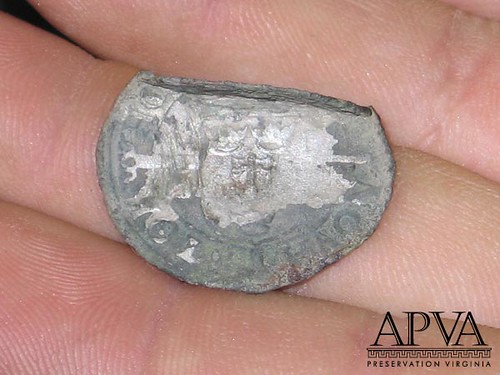
PREV ARTICLE
NEXT ARTICLE
FULL ISSUE
PREV FULL ISSUE
LITERATURE ON WORLD COINS CIRCULATING IN EARLY AMERICA
Len Augsburger let me know about this great new article on John Kraljevich's web site. Thanks! Here are some excerpts. Be sure to read the whole thing!
-Editor

17th century Swedish silver coin found at colonial Jamestown The inquiry I received this morning had to do with books. I like questions about books. An educated customer is our best customer. The collector has an interest in the foreign coins that circulated in early America, from colonial times until the end of foreign coins' legal status in the United States in 1857, and was curious to know what kind of published literature there was on the subject. Admittedly, there's not much out there. In fact, it's a topic that deserves its own book and I'd love to write it someday. The proportion of foreign coins in circulation in the U.S. was substantial until the Civil War. Luckily, the types are well documented – but the information is scattered throughout a variety of obscure primary sources. The best are U.S. Mint reports and other official publications. Books like 1850's A Manual of Gold and Silver Coins of All Nations by Eckfeldt and Dubois not only offered insight into what came into the Mint in assays, but summarized the various Congressional acts that described the values of the common coins then found in circulations. The same information can be found in American State Papers, offprinted Mint reports, or other government publications. Adding to the broad strokes Congress took to identify and value foreign coins then in commerce, other contemporary literature – almanacs, magazines, newspapers, even fictions – can complete the picture of coins in circulations. In modern times, the various post-1793 Mint acts that regulated foreign coins were published with illustrations (and values) of the relevant types as America's Foreign Coins by Raphael Solomon and Oscar Schilke. Now out of print, the book is useful, though not exactly chock-full of facts. It is easily found among the inventories of numismatic literature dealers. Unfortunately, the Schilke-Solomon book only covers laws (and types) after the foundation of the U.S. Mint. The wide variety of foreign coins circulating in colonial and Confederation-era America is ably covered in Phillip Mossman's Money of the American Colonies and Confederation. Issued at a price tag near $100, some phone calls to numismatic booksellers may well reveal a lower price tag. Go buy it. It's academic, it has graphs and charts, and the footnotes sometimes take up more of the page than the text. It's brilliant. If I could only take one book to a desert island and still hope to still write columns on colonial coins, I'm not sure I wouldn't take Mossman instead of Crosby. Using contemporary references and archaeological information, Mossman paints an accurate picture of the mess of domestic and foreign types in early America. The archaeological evidence is especially important, since the finds of coins here and there in small digs are published one at a time in obscure non-numismatic publications. Rarely do they see numismatic sunlight. Crosby's 1875 The Early Coins of America is useful in the same way Schilke-Solomon is, aside from the latter volume's pictures and quaint 60's-era pricing, which is to say it has the original text of laws that regulate the value of foreign coins in circulation. It's often a dry read, and the terms used by colonial legislatures were not numismatically precise and require interpretation, but the facts are often best found in those legal papers. The often-overlooked monograph by Joe Lasser entitled The Coins of Colonial America is a treasure trove, despite its brevity. Illustrated by some of the mgnificent pieces he gave Colonial Williamsburg, the book shows the wide variety of world trade coins – silver and gold – that found their way to American shores. In an appendix, many of the coins that have been archaeologically recovered at Williamsburg also make an appearance. It's the textbook Erik Goldstein and I use every summer in our ANA Summer Seminar class.
To read the complete article, see:
The Literature On World Coins Circulating in Early America: An Inquiry
(kraljeblog.blogspot.com/2011/03/literature-on- The Numismatic Bibliomania Society is a non-profit organization promoting numismatic literature. See our web site at coinbooks.org. To submit items for publication in The E-Sylum, write to the Editor at this address: whomren@gmail.com To subscribe go to: https://my.binhost.com/lists/listinfo/esylum All Rights Reserved. NBS Home Page Contact the NBS webmaster 
|